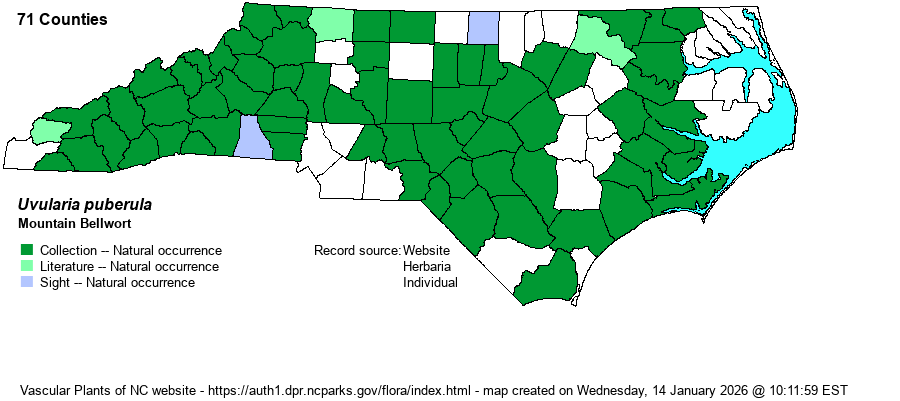| Author | Michaux | |
| Distribution | Present over all of the Mountains, and scattered over nearly all of the Piedmont and Coastal Plain. Apparently absent from the extreme eastern counties (north and south of Albemarle and Pamlico sounds).
This species has a rather small range for a "lily", it being limited to an area from Long Island, NY, and southern PA south to central GA. It is mainly found in VA, NC, and SC, plus eastern WV. | |
| Abundance | Despite its wide range in the state, known from roughly 70 counties so far, it is not an overly common species. It is fairly common to frequent in the Mountains and foothills, but much less numerous eastward. In the rest of the state it is uncommon, and even locally rare in some areas. | |
| Habitat | This is the only bellwort favoring dry sites. It occurs on bluffs, dry wooded slopes, barrens, and other mostly acidic and dry sites. It frequently occurs with ericaceous shrubs such as Rhododendron species, Mountain Laurel (Kalmia latifolia), or various blueberry (Vaccinium) and huckleberry (Gaylussacia) species. Only rarely is it found in moist areas, but again generally in quite acidic soils, such as borders of pocosins. | |
| Phenology | Blooms from late Match to early May, and fruits from August to October. | |
| Identification | This is one of the smaller/shorter "lily" species in the state, it normally growing just to a height of 6-8 inches tall. Only a very few entire and elliptical stem leaves are present, each being thick, shiny, and dark green, quite different in color and texture from the leaves of the other three bellwort species. These leaves are about 2 inches long and 1 inch wide, but are sessile and are not perfoliate; most of the leaves are strongly ascending. A few dangling pale yellow flowers are present from the several branches on the stem; the flowers are about 3/4-inch long. The other bellwort with sessile leaves -- U. sessilifolia -- has thin, flexible, yellow-green leaves, and the leaves are always arranged horizontally or are drooping. In addition, U. puberula usually grows singly or as scattered individuals, whereas U. sessilifolia is strongly colonial, often seen in large and densely packed stands in floodplain forests. Mountain Bellwort is not too hard to find in the mountains, where at times it might be one of just a few wildflowers in bloom in its usually xeric and rocky habitats. | |
| Taxonomic Comments | This species was named as Uvularia pudica in many earlier publications, such as in RAB (1968). Some authors treat U. puberula as having both a Coastal Plain variety (var. nitida) and a montane/Piedmont variety (var. puberula). Weakley (2018) says "The differences seem minor and variable, and poorly correlated with geography"; neither he nor NatureServe list varieties, though the NC NHP database still retains the nitida variety.
| |
| Other Common Name(s) | Carolina Bellwort, Coastal Bellwort | |
| State Rank | S5 | |
| Global Rank | G5 | |
| State Status | | |
| US Status | | |
| USACE-agcp | FAC link |
| USACE-emp | FACU link |

